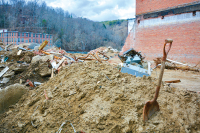Jackson’s new industrial ordinance limits fracking, emphasizes traffic considerations

After sixteen months of meetings, a change of planning director and a nearly complete turnover of membership on the Jackson County Planning Board, an updated industrial development ordinance is now in place for the county.
The new document looks similar to the old one, which was completed in 2002, but with a few key changes: hydraulic fracturing — or fracking — is explicitly listed under the mining industries the ordinance governs, and a process is outlined requiring industrial businesses to consider their impact on road transportation.
“The attention they (the planning board) paid to it and the care they took in going through it in making these changes is what accounts for that (two-year) timeframe and how looking at the ordinance there’s not a whole new structure of how we are going to address these issues,” said Jackson Planning Director Michael Poston.
Focus on fracking
The industrial development ordinance swiveled to the radar of the newly elected board of commissioners shortly after their December 2014 swearing in as a way to protect the county from fracking, then a hot-button issue. The state had just finished a circuit of public hearings asking for input on newly drafted rules to govern the industry in North Carolina. Statewide, the hearing in Cullowhee was the most heavily attended, drawing a roster of speakers unanimously opposed to fracking in this neck of the woods.
Because the state law allowing fracking explicitly stated that local governments couldn’t outlaw it in their jurisdictions, the new, predominantly Democrat board began looking for creative ways to keep the industry at bay — even contacting the Natural Resources Defense Council for legal advice.
Related Items
As a result, fracking was listed under the mining definition during the planning board’s very first meeting to discuss the ordinance, back in April 2015.
“In general we don’t want to set a lot of conditions to prohibit something. We just prohibit it,” planning board chair Scott Baker said at the board’s May meeting, acknowledging the unique situation caused by the state law’s ban on local prohibitions. “In this case using the mining ordinance that is pretty restrictive pretty much covers most scenarios that would allow it (fracking) to happen.”
Subsequent work sessions went through the 16-page ordinance line-by-line, scouring the document for definitions in need of updating and stipulations in need of changing.
One noticeable difference is that fracking is included throughout the ordinance, rather just in the definition of mining, making it clear throughout that all of the setback and screening regulations that apply to other mining operations apply to fracking.
According to geology’s best guess, however, Western North Carolina’s oil and gas reserves are small at best, so despite the emotional nature of the issue, fracking is unlikely to ever come to the area. In fact, Jackson County isn’t exactly a Mecca for any other heavy industries, either — Poston couldn’t find record of any heavy industry permits being issued since the original ordinance passed in 2002.
That doesn’t mean the rules aren’t important to have in place, Commission Chairman Brian McMahan said.
“We don’t want to wait until we’re in a bind and all of a sudden someone puts in an application and we come in and try to make changes,” he said. “It’s good to do it now and try to be proactive.”
Planning for traffic
In terms of everyday impact, an ordinance change aimed at keeping big industrial rigs off country roads too small to handle them will likely be the most significant.
“Right now they can have impacts on any road,” Poston told the planning board in May. “It could be a small dirt road. Is it designed to handle that?”
The revised ordinance requires that industries covered under the ordinance be located along a main road — an artery like U.S. 441, U.S. 23 or N.C. 107. If the industry wants to locate somewhere else, it has to have a traffic engineer complete a traffic assessment looking at potential congestion and functionality issues between the site and nearest primary road.
After reviewing the report, the planning department can either OK the permit or give the applicant the option of completing a more intensive Transportation Impact Analysis, whose results would be considered by the Jackson County Board of Adjustment in a quasi-judicial hearing, a proceeding similar to a court case. To get a permit, the analysis would have to show that the traffic wouldn’t have any adverse impacts, that the use is consistent with the county’s land use plan, and that it wouldn’t endanger public health, safety or the natural environment.
This ordinance isn’t the first in Jackson to consider traffic in land use decisions. Newer ordinances, like the Cullowhee and U.S. 441 Corridor planning ordinances, have stipulations regarding traffic, and it’s not an uncommon consideration in other local governments across the state, Poston said.
“If you’ve got one of these businesses and you’re not locating on your major thoroughfares like your 107s, your 441, you’d have to address how the transportation that’s created by that use, how it affects the existing network,” Poston said.
Poston said his office hasn’t received any negative feedback from people involved with industrial business. In fact, the only person who spoke during the public hearing preceding commissioners’ vote on the ordinance was of the persuasion that the rules aren’t strong enough.
Donna Dupree, a Balsam resident who’s been an outspoken opponent of fracking, told commissioners that the county should require heavy industry to show proof of liability insurance and to post a bond before beginning any mining activities. She also requested a larger fine for ordinance violations — $1,000 instead of $500 per day — and that the setback from homes, schools and hospitals be increased from one-quarter mile to one-half mile.
Poston addressed Dupree’s concerns before the vote, asserting that it’s not “commonplace to hold a bond or require a certain amount of liability insurance on classes of businesses” and that setback requirements can be surprisingly restrictive at seemingly short distances when you consider the entire 360-degree circle around a particular point. Make the setback too big, and pretty soon there’s no location in the county capable of fulfilling the requirement.
“The question becomes where’s the balance at?” he said.
There may always be questions and discussions and possibilities for changes to the ordinance, McMahan said, but he thanked the planning board for the document they had arrived at.
“For the purpose of today,” he said, “this is a good start.”









